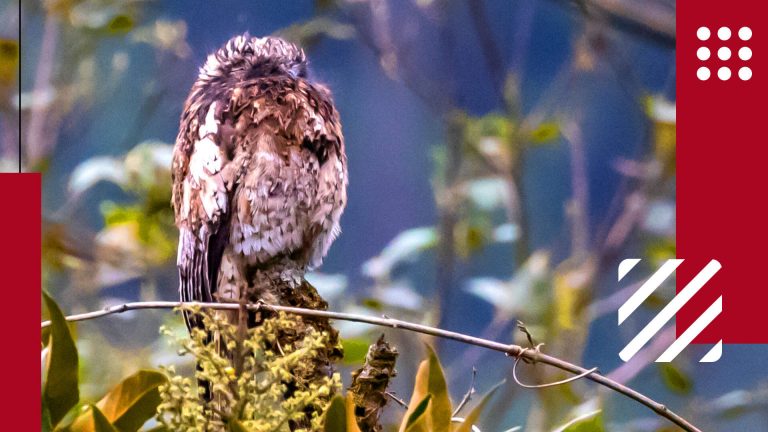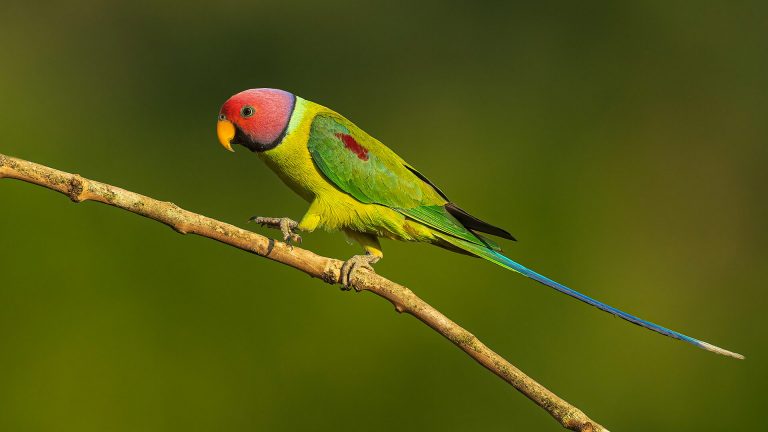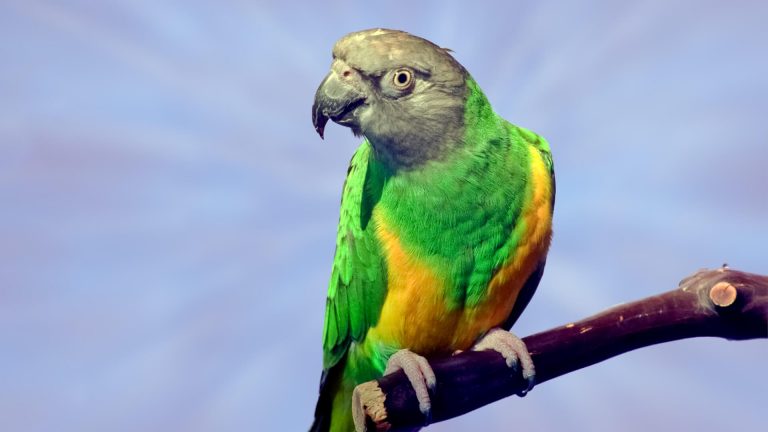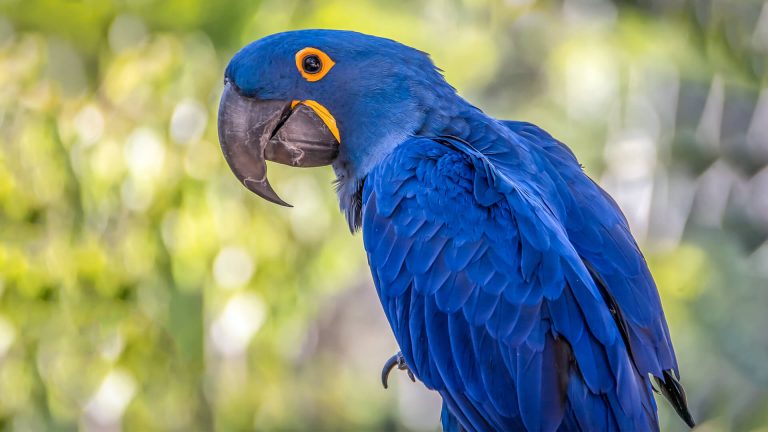The Rainbow Lorikeet is a species of parrot native to Australia and some nearby islands. They are brightly colored birds with a distinctive rainbow-like plumage, hence their name. These birds are known for their playful and inquisitive nature, as well as their ability to mimic human speech. They are found in a variety of habitats, including forests, woodlands, and urban areas.
Distinctive Features of Rainbow Lorikeet
| Scientific Name | Trichoglossus moluccanus |
| Lifespan | Up to 30 years |
| Color | Brightly colored with a rainbow of feathers |
| Size | Up to 12 inches |
| Weight | Up to 150 grams |
| Health Risk | Low |
| Cage Size | Minimum 36" x 48" x 24" |
| Unique Trait | Brilliant and varied coloration |
| Famous For | Vibrant plumage and playful nature |
| Temperament | Active, energetic, and playful |
| Maintenance | Moderate |
| Adaptability | Moderate |
| Behavior | Social, enjoys interaction and play |
| Personality | Affectionate, intelligent, and vocal |
| Social | Highly social, enjoys the company of other birds |
Rainbow Lorikeets are brightly colored birds with a distinctive rainbow-like plumage. The colors of their plumage can vary, but they are typically green, blue, red, and yellow, with some individuals having orange or purple markings. They have a brush-tipped tongue that they use to feed on nectar, pollen, and fruit.
In terms of size, Rainbow Lorikeets are medium-sized parrots. They typically reach lengths of around 25-30 cm (10-12 inches), with a wingspan of around 45 cm (18 inches).
As for lifespan, Rainbow Lorikeets can live for around 20-30 years in the wild, and potentially even longer in captivity with proper care. However, their lifespan can vary depending on factors such as diet, habitat, and access to medical care.

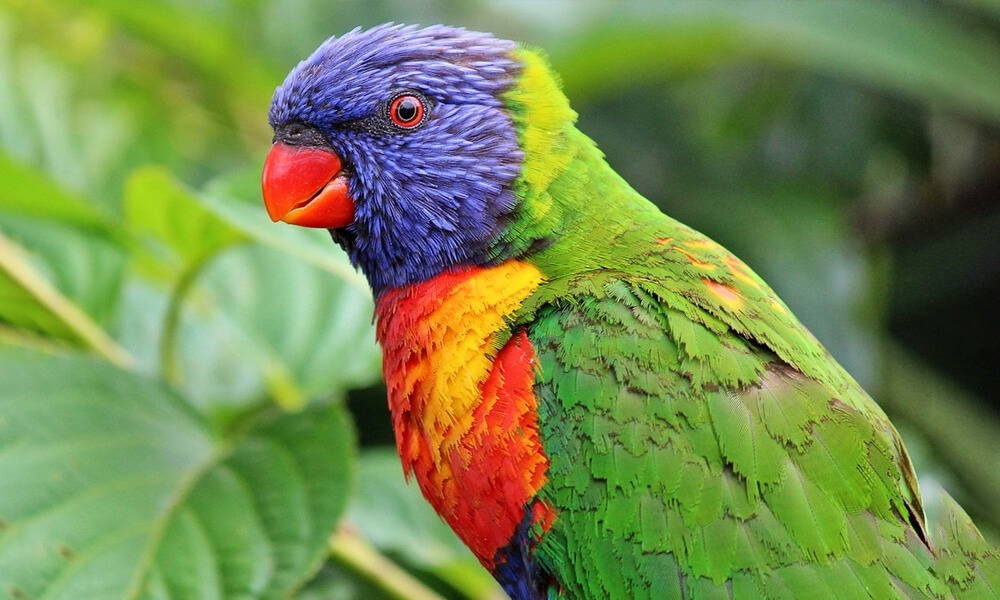
How to Take Care of Pet Rainbow Lorikeet?
Taking care of a pet Rainbow Lorikeet requires special attention to their diet, housing, socialization, and overall health. These colorful and playful birds have specific needs that must be met to ensure their well-being and happiness.
How to Set Up a Habitat for Pet Rainbow Lorikeet?
If you are interested in setting up a habitat for a Rainbow Lorikeet, there are a few things to consider. Rainbow Lorikeets are active and playful birds, so they will need plenty of space to move around and play. A large cage or aviary is recommended, with plenty of horizontal and vertical space for the bird to climb and explore. The cage or aviary should be placed in a well-lit area, away from direct sunlight and drafts.
In terms of furnishings, Rainbow Lorikeets will need perches of varying widths and textures, as well as toys and objects to chew and play with. They also enjoy bathing, so a shallow dish of water or a small misting system can be provided for them to splash around in.
What to Feed Your Pet Rainbow Lorikeet?
Rainbow Lorikeets are omnivorous birds and need a varied diet to stay healthy. In the wild, they feed on nectar, pollen, fruit, and insects. In captivity, they can be fed a diet of commercial parrot pellets, fruits, vegetables, and occasional treats such as cooked eggs or small amounts of seeds.
Offer a variety of foods to provide the bird with the nutrients they need. Fruits and vegetables can be offered fresh, frozen, or cooked, and can include items such as apples, pears, berries, peas, beans, and leafy greens. Pellets should make up the majority of the bird's diet, and should be offered in a separate dish from the fresh foods to prevent contamination.
In addition to a healthy diet, provide fresh water at all times, and to clean and disinfect the bird's food and water dishes regularly to prevent the buildup of bacteria and other harmful substances. Offer food and water at the same times each day to establish a regular feeding routine, and monitor the bird's food intake and overall health to ensure they are getting the nutrition they need.
What to Avoid Feeding Your Pet Rainbow Lorikeet?
In general, avoid feeding Rainbow Lorikeets any foods that are harmful or toxic to them. This includes things like chocolate, caffeine, alcohol, avocado, and processed, sugary, or fatty foods. These foods can be harmful to the bird's health and should be avoided.
Avoid feeding Rainbow Lorikeets any foods that have spoiled or gone bad, as these can contain harmful bacteria that can make the bird sick. Offer fresh, high-quality food and water, and discard any food that has been left out for more than a few hours to prevent bacterial contamination.
In addition, avoid feeding Rainbow Lorikeets any foods that contain seeds or pits, as these can be a choking hazard for the bird. Offer fruits and vegetables that have been chopped or mashed into small, easily consumed pieces, and avoid giving the bird whole fruits or vegetables that they may have difficulty eating.
Grooming & Hygiene Needs of Pet Rainbow Lorikeet
Grooming and maintaining the hygiene of your pet Rainbow Lorikeet is essential to keep them healthy and in optimal condition. Here are some grooming and hygiene needs specific to Rainbow Lorikeets:
- Feather Care: Rainbow Lorikeets have unique brush-like tongues and specialized feathers that require regular care. Their feathers produce a powdery substance called "powder down" which helps in keeping the feathers clean and maintaining their waterproofing. However, this powder can accumulate and form a dusty layer on surfaces around their cage. Regularly clean their cage and surrounding areas to prevent excessive dust buildup.
- Bathing: Rainbow Lorikeets enjoy bathing and it is an important part of their grooming routine. Provide them with a shallow dish or spray bottle filled with clean, lukewarm water for bathing. Some lorikeets may prefer misting, while others may enjoy dipping or splashing in water. Observe their preferences and provide them with bathing opportunities at least a few times a week.
- Nail Trimming: Check your Rainbow Lorikeet's nails regularly and trim them as needed. Overgrown nails can be uncomfortable for the bird and may even cause injury. Use appropriate bird nail trimmers or seek guidance from an avian veterinarian on how to trim their nails safely. Be cautious not to trim too close to the quick, as it can cause bleeding.
- Beak Maintenance: Rainbow Lorikeets have strong and sharp beaks that they use for various activities, including eating, climbing, and exploring. Providing them with appropriate chewable toys and branches can help keep their beak naturally worn down. However, in some cases, their beak may grow excessively and require professional beak trimming. Consult with an avian veterinarian if you notice abnormal beak growth.
- Wing Clipping: Wing clipping is a personal choice and depends on your specific circumstances and the bird's safety. If you decide to clip your Rainbow Lorikeet's wings, it is recommended to have it done by an experienced avian veterinarian or a professional bird groomer. This helps prevent accidental injuries or escapes while allowing your lorikeet to have controlled and safe flight.
- Hygiene: Regularly clean your Rainbow Lorikeet's cage and accessories to maintain proper hygiene. Remove any droppings, uneaten food, or soiled bedding on a daily basis. Clean the perches, toys, and dishes with bird-safe cleaning products or mild soapy water. Rinse thoroughly to remove any residue and ensure they are completely dry before placing them back in the cage.
- Monitoring Health: Pay close attention to your Rainbow Lorikeet's overall health and appearance. Regularly inspect their feathers, skin, eyes, and feet for any signs of abnormalities, parasites, or injuries. Monitor their droppings for consistency and color changes, as it can be an indicator of their health status. If you notice any concerning changes or symptoms, seek veterinary advice promptly.
Rainbow Lorikeets have specific grooming needs due to their unique feathers and feeding habits. Educate yourself about their care requirements and consult with an avian veterinarian or an experienced bird groomer for guidance on specific grooming practices for your pet Rainbow Lorikeet.
Health Concerns of Rainbow Lorikeet
Rainbow Lorikeets, like all pet birds, can be susceptible to certain health issues. Some of the most common health concerns for rainbow lorikeets include:
- Lorikeet Paralysis Syndrome (LPS): Lorikeet Paralysis Syndrome (LPS) is a neurological disorder affecting lorikeets, characterized by muscle weakness, paralysis, and in severe cases, death. It is often caused by a viral infection.
- Beak and Feather Disease (PBFD): Beak and Feather Disease (PBFD) is a contagious viral infection that affects birds, causing feather abnormalities, beak deformities, and weakened immune systems, potentially leading to death.
- Respiratory conditions: Common respiratory conditions in lorikeets include respiratory tract infections, pneumonia, tracheitis, bronchitis, and sinusitis. Symptoms may include coughing, sneezing, wheezing, nasal discharge, and difficulty breathing. Veterinary care is essential for diagnosis and treatment.
- Chlamydiosis: Chlamydiosis is a common and potentially fatal disease in lorikeets caused by the bacterium Chlamydia psittaci. Symptoms include respiratory distress, lethargy, and diarrhea. Prompt veterinary care is crucial for treatment and prevention.
- Psittacine beak and feather disease: Lorikeet affected by psittacine beak and feather disease, a viral infection causing feather loss, beak deformities, and a weakened immune system.
- Hemochromatosis: Hemochromatosis is a condition in lorikeets characterized by excessive iron absorption, leading to iron buildup in various organs, potentially causing organ damage and death.
- Nutritional deficiencies: Rainbow Lorikeets require a balanced and varied diet to stay healthy and can develop nutritional deficiencies if their diet is not properly balanced. Symptoms of nutritional deficiencies can include feather loss, poor growth, and decreased activity levels.
- Infections: Rainbow Lorikeets are prone to bacterial and fungal infections, which can affect the skin, feathers, and respiratory system. Symptoms of infection can include lethargy, loss of appetite, and difficulty breathing.
- Injuries: Rainbow Lorikeets are active birds and can injure themselves if their habitat is not properly furnished or maintained. Injuries can include broken bones, cuts, and bruises, and can be painful and potentially life-threatening if not treated promptly.
- Parasites: Rainbow Lorikeets can be infected with internal and external parasites, such as worms and mites, which can cause a variety of health problems. Symptoms of parasitic infection can include weight loss, poor feather condition, and diarrhea.
Monitor your Rainbow Lorikeet's health regularly and seek veterinary care if you notice any changes in their behavior or appearance. Regular check-ups and preventive care can help to keep your rainbow lorikeet healthy and prevent potential health issues.
What It's Like to Keep Rainbow Lorikeet as a Pet?
The Rainbow Lorikeet is a vibrant and energetic parrot known for its colorful plumage, playful nature, and lively personality. Here's what it's like to have a Rainbow Lorikeet as a pet:
Temperament: Rainbow Lorikeets are known for their active and social nature. They are highly intelligent, curious, and love to explore their surroundings. They are generally friendly and enjoy interacting with their human companions. They can be quite vocal and have a variety of calls and squawks.
Bonding and Socialization: Rainbow Lorikeets thrive on social interaction and require plenty of attention and mental stimulation from their owners. They have a strong need for companionship and can become lonely if left alone for long periods. It's important to spend time with them, handle them gently, and provide them with toys and activities to keep them engaged.
Playfulness and Enrichment: Rainbow Lorikeets are highly active and enjoy playtime. Providing them with a variety of toys, swings, and climbing structures in their cage can help keep them entertained and mentally stimulated. They also appreciate time outside of their cage for supervised play and exploration.
Vocalizations: Rainbow Lorikeets are known for their vocal abilities and can be quite loud at times. They have a range of calls, squawks, and mimicry abilities. While their vocalizations can be charming, they may not be suitable for noise-sensitive households or apartment living.
Legal Considerations: Before considering a Rainbow Lorikeet as a pet, it's important to check local laws and regulations regarding ownership. In some regions, a permit may be required to keep certain species of parrots.
Other Pets to Keep or Avoid with Rainbow Lorikeet
Rainbow Lorikeets are social birds and can get along well with other pets, as long as proper introductions and precautions are taken. However, there are some pets that may not be suitable companions for Rainbow Lorikeets, and as a responsible pet owner you should consider these factors when deciding what other pets to keep with a rainbow lorikeet.
Some pets that may be suitable companions for Rainbow Lorikeet include other birds, such as parakeets or lovebirds, as well as small mammals like guinea pigs or rabbits. These animals can provide the Rainbow Lorikeet with social interaction and entertainment, and can potentially even form friendships with the bird.
On the other hand, there are some pets that may not be suitable companions for Rainbow Lorikeet. For example, cats and dogs can be a potential danger to Rainbow Lorikeets, as they may view the bird as prey or be too rough in their interactions. Supervise any interactions between rainbow lorikeets and other pets to ensure the safety of both animals.
Facts About Rainbow Lorikeet
Here are a few interesting facts about Rainbow Lorikeets:
- Rainbow Lorikeets are native to Australia and some nearby islands.
- They are brightly colored birds with a distinctive rainbow-like plumage, with colors that can vary from individual to individual.
- Rainbow Lorikeets are known for their playful and inquisitive nature, as well as their ability to mimic human speech.
- Rainbow Lorikeets are social birds and can form strong bonds with their human caregivers and other pets.
- They are protected under the Convention on International Trade in Endangered Species (CITES), which regulates the trade of threatened and endangered species.
Frequently Asked Questions About Rainbow Lorikeet
Here are some answers to frequently asked questions about rainbow lorikeets:
What do Rainbow Lorikeet look like?
Rainbow Lorikeets are brightly colored birds with a distinctive rainbow-like plumage. They are typically green, blue, red, and yellow in color, with some individuals having orange or purple markings. They have a brush-tipped tongue that they use to feed on nectar, pollen, and fruit.
Where do Rainbow Lorikeets live?
Rainbow Lorikeets are native to Australia and some nearby islands. They are found in a variety of habitats, including forests, woodlands, and urban areas.
How long do Rainbow Lorikeets live?
Rainbow Lorikeets can live for around 20-30 years in the wild, and potentially even longer in captivity with proper care. Their lifespan can vary depending on factors such as diet, habitat, and access to medical care.
Can Rainbow Lorikeets talk?
Rainbow Lorikeets are intelligent birds and can learn to mimic human speech. They are known for their ability to mimic sounds and words and can sometimes even learn to hold simple conversations.
Can Rainbow Lorikeets be kept as pets?
Rainbow Lorikeets can be kept as pets, but it's important to consider the time and commitment required to properly care for these active and playful birds. They need a spacious and well-furnished habitat, a healthy and varied diet, and regular socialization and interaction to stay happy and healthy.


